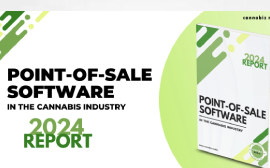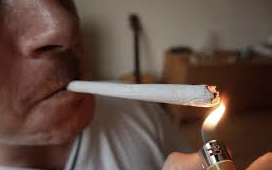MRR writes
The perpetual myth that dispensaries are selling weed to minors refuses to die, but evidence shows this isn’t the case in California. Instead, adult-use dispensaries in the state are proving the system works by checking IDs as required by state law.
A new study disproves the theory that dispensaries make it easier for teens to get cannabis. Researchers sent out undercover patrons who looked underage to 50 randomly selected dispensaries in California to see if they could get weed without first furnishing an ID, as required. All dispensaries involved passed the test, which researchers admitted was “somewhat surprising.”
In California, people 18-20 with a doctor’s recommendation and any adult 21 and over can purchase cannabis.
The study, entitled “What is the likelihood that underage youth can obtain marijuana from licensed recreational marijuana outlets in California, a state where recreational marijuana is legal?” was published in the Journal of Safety Research and made available online on May 18.
To Read The Rest Of This Article On High Times, Click Here
Journal of Safety Research
What is the likelihood that underage youth can obtain marijuana from licensed recreational marijuana outlets in California, a state where recreational marijuana is legal?
Abstract
Objective: Since 2012, 19 states and the District of Columbia have legalized the recreational use of marijuana for adults ages 21 and older. Marijuana use at any level can impair driving performance. Prior research on enforcement of the minimum legal marijuana use age of 21 (MLMU-21) laws is limited. The objective of the current study was to assess the ease of access to marijuana by underage patrons at recreational marijuana outlets in California, where recreational marijuana was legalized in 2016. Method: Pseudo-underage patrons were sent to 50 randomly selected licensed recreational marijuana outlets in the state to see if they could enter the outlet without showing a valid identification of their age. Results: Pseudo-underage patrons were required to show age identification to enter in 100% of the licensed recreational marijuana outlets visited. Conclusions: It appears that licensed California recreational marijuana outlets avoid selling marijuana to underage customers. One reason could be a strong incentive for recreational marijuana outlet owners and managers to avoid being shut down for an illegal activity. Practical Application: Underage youth are not obtaining marijuana at licensed recreational outlets. Future studies and cannabis enforcement agencies should investigate whether underage patrons attempt to use fake IDs at licensed marijuana outlets and whether youth are obtaining marijuana from illicit dispensaries or from social sources.
Introduction
One of the most successful alcohol control policies in the United States was the establishment of the minimum legal drinking age of 21 (MLDA-21). All states have a version of MLDA-21, with Congress passing legislation in 1984 pressuring all states to enact the policy if they had not already done so. Even absent strict enforcement, an abundance of research has shown the MLDA-21 policy to be very effective in reducing underage impaired driving (Dang, 2008, Decker et al., 1988, Jones et al., 1992, O’Malley and Wagenaar, 1991, Shults et al., 2001, Toomey et al., 1996). Now that marijuana has become legal for recreational use in a number of U.S. states (as of July 1, 2021: Alaska, Arizona, California, Colorado, Connecticut, Illinois, Maine, Massachusetts, Michigan, Montana, Nevada, New Jersey, New Mexico, New York, Oregon, South Dakota, Vermont, Virginia, Washington) and the District of Columbia, it is important to examine laws surrounding the minimum legal marijuana use age of 21 (MLMU-21) to determine if they are effective in reducing access to marijuana by underage youth. There is some evidence from Colorado that traffic deaths involving marijuana-positive drivers increased in the 3 years after the state legalized recreational marijuana compared with the 3 years prior to legalization. There is also evidence that past-month marijuana use by youth increased in the 2 years after legalization compared with the 2 years prior to legalization (Wong, Clarke, & Harlow, 2016). Note that the presence of marijuana in drivers does not necessarily mean impairment. In a more current report from Colorado from the Rocky Mountain HIDTA Training and Information Center (2020), it was reported that since recreational marijuana was legalized in 2013, past month youth (ages 12–17) marijuana use decreased 25% yet is 43% higher than the national average, currently ranked 7th in the nation.
If marijuana is easily accessible to youth, it is possible that more youth will drive after marijuana use (Li, Hu, Schwebel, & Zhu, 2020). A report by the National Academies of Sciences, Engineering, and Medicine (2017) concluded that there is “substantial evidence of a statistical association between cannabis use and increased risk of motor vehicle crashes” (p 9–11) based upon systematic reviews of the evidence (Asbridge et al., 2012, Calabria et al., 2010, Elvik, 2013, Hartman and Huestis, 2013, Rogeberg and Elvik, 2016). In a 2013–2014 National Roadside Survey, more drivers tested positive for cannabis (12.6%) than for alcohol (8.3%; Berning, Compton, & Wochinger, 2015) with drivers aged 16–20 having the highest rates. Romano and Pollini (2013) examined fatally injured drivers in single-vehicle crashes from the Fatality Analysis Reporting System (FARS) in states that tested 80% or more of the drivers for alcohol and other drugs in the years 1998–2010. The researchers found that 45.1% tested positive for alcohol, while 25.9% tested positive for other drugs including cannabis (7.1%). Note once again that the presence of marijuana in drivers does not necessarily mean impairment. In a review of the literature on the effects of cannabis on driving, tetrahydrocannabinol (THC) concentrations of 2–5 nanograms (the active ingredient in cannabis) per milliliter (ng/ml) were associated with substantial driving performance decrements, especially with tasks involving divided attention (Hartman & Huestis, 2013). It should be noted that these were laboratory studies in which drivers were dosed with THC and were in driving simulators, not driving on roads (see also Rogeberg & Elvik, 2016). In Europe, however, researchers measured driving performance in normal traffic under THC alone, THC combined with alcohol, and placebo conditions. Low doses of THC moderately impaired driving performance in terms of standard deviation of lane position, time driven out of lane, reaction time, and standard deviation of headway, but severely impaired performance when combined with a low dose of alcohol (Ramaekers, Robbe, & O’Hanlon, 2000). Hartman and Huestis (2013) concluded that cannabis caused impaired cognitive function and increased lane weaving in the laboratory studies that they reviewed. These laboratory studies found that THC caused impairment in critical tracking tests, reaction time, divided attention tasks and lane position maintenance. The results of these studies suggest that cannabis consumption negatively impacts driving performance, which is of particular concern when compounded with youths’ relative inexperience driving and propensity for risk-taking (Hartman and Huestis, 2013, Leadbeater et al., 2017).
In other areas of concern, a survey by Cerda (2017) studied the effects of marijuana legalization in Colorado and Washington. The authors found that, in Washington, the perceived harmfulness of marijuana by youth decreased after legalization. In addition, the prevalence of regular users of marijuana increased among Washington high school students after legalization. Increased use could potentially lead to more cannabis-impaired driving by youth.
There is a parallel with alcohol control. Underage drinking laws focus on: (a) control of furnishing and selling alcohol to youth, (b) possession and consumption of alcohol by youth, and (c) prevention of impaired driving by those ages 20 and younger. Strong evidence exists that such laws can reduce underage alcohol-related traffic fatalities (Fell et al., 2016, O’Malley and Wagenaar, 1991, Ponicki et al., 2007, Shults et al., 2001, Voas et al., 2003), but there is wide variability in the strength of laws and the number of states that have adopted each of them (Fell, Thomas, Scherer, Fisher, & Romano, 2015).
In addition, the effectiveness of MLDA-21 laws depends on enforcement. An early study sent 18- to 20-year-old pseudo-patrons to attempt to purchase a six-pack of beer at randomly selected outlets in three communities (Preusser & Williams, 1992). The success rate ranged from 44% to 97%. The lowest rate (44%) was in a community where law enforcement had recently enforced underage alcohol laws using compliance checks (i.e., underage youth attempted to purchase alcohol under supervision of law enforcement) resulting in 50 publicized arrests of sellers. More recent estimates of illegal sales for young-appearing buyers have ranged from 26% to 39% across cities (Britt et al., 2006, Freisthler et al., 2003, Toomey et al., 2008).
Research on MLDA-21 laws is relevant to marijuana. If underage marijuana use can be reduced, it is reasonable to assume that underage marijuana-impaired driving can also be reduced (Shults et al., 2001). Currently (as of July 1, 2021), 19 states and the District of Columbia have officially legalized both medical and recreational marijuana use. All 19 states with legalized recreational marijuana prohibit recreational marijuana purchase by persons under age 21. However, youth who obtain a medical marijuana certificate can purchase and use medical marijuana at age 18 and older. There appears to be very little research on the effectiveness of underage marijuana laws in these states.
Limited, initial research suggests high rates of compliance with MLMU-21 laws. A Colorado study (Buller, Woodall, Saltz, & Starling, 2016) found that 95% of pseudo-underage buyer attempts were unable to purchase marijuana at licensed recreational outlets. The Washington State Liquor and Cannabis Board (2018) reported that 92% of 2,664 underage compliance checks conducted in the state between 2015 and 2018 resulted in the sales being denied. Although this is encouraging, we have not identified studies examining the ease of underage access to marijuana in other states that have retail recreational marijuana outlets. This includes the largest state to legalize recreational marijuana — California.
California has a number of MLMU-21 laws (Table 1). However, California does not have the following laws for marijuana that it has for alcohol: (a) a law prohibiting the use of false identification for purchases, (b) a social-host liability law, and (c) mandatory responsible sales training.
There is some evidence that frequent use of marijuana by youth is associated with driving after marijuana use. Leadbeater et al. (2017) reported that 64% of males and 33% of females who reported frequent use of marijuana also reported that they were intoxicated with marijuana while operating a vehicle in the last 30 days. Li et al., (2020) reported from the 2017 Youth Risk Behavior Survey that among teen drivers reporting marijuana use, close to half (48.8%) reported driving after marijuana use. Paschall, Garcia-Ramirez, and Grube (2021) found that the legalization of marijuana in California was associated with an increase in adolescent marijuana use in 2017–2018 and 2018–2019. There is some concern that if recreational marijuana outlets are selling marijuana to underage youth, there could possibly be an increase in youth driving after marijuana use (Li et al., 2020).
Johnston et al. (2019) reported from the Monitoring the Future National Survey on Drug Use that 80–90% of 12th graders reported that marijuana is easy to obtain. In the 2018 Analytic Report from the Washington State Healthy Youth Survey (Looking Glass Analytics Inc, 2019), the usual sources of marijuana among current grade 12 marijuana users were: 28% from friends; 17% at a party; 15% gave money to an adult to buy it; 14% from home; 6% from an older sibling; 6% bought it from a marijuana outlet; 5% stole it from an outlet; 7% reported other sources. While a small percentage (6%) reported buying marijuana at an outlet, it is unclear where friends (28%) obtained it or where the people at a party (17%) obtained it. Using data from the National Survey on Drug Use and Health (NSDUH) 2012 data, King, Merianos, and Vidourek (2016) found that 34% of adolescents aged 12–17 obtained cannabis for free from family and/or friends, most likely because they were not able to legally purchase it.
There is a need to determine the ease of access to marijuana by youth under age 21 at licensed recreational marijuana outlets. This information will help assess the effectiveness of current underage marijuana laws. Conducting this assessment in the largest U.S. state, California, is an important part of building the research literature in this area. The basic objective of this study was to assess the ease of access to marijuana by underage patrons at retail outlets in California, where the penalty for furnishing marijuana to someone under age 21 is up to 6 months in jail and up to a $500 fine for a first offense.
Section snippets
Method
To meet this objective, pseudo-underage entrance attempts in a random sample of marijuana outlets in California were conducted. All data collection was completed prior to the COVID-19 pandemic.
Results
The two data collection teams were able to collect data at 47 of the 50 retail outlets. Of the 47 outlets at which observations were made, 10 were alternate outlets. The three field sites and their alternates that the team was unable to observe did not sell cannabis for recreational use. In some cases, these locations sold cannabis for medical use only. In other cases, the indicated locations were abandoned buildings or other businesses entirely. One site and its alternates were located in a
Discussion
It was somewhat surprising that there was 100% compliance with the ID policy to keep underage patrons from purchasing marijuana directly from licensed outlets. However, that was consistent with what was observed in two other states, Washington and Colorado (Buller et al., 2016, Washington State Liquor and Cannabis Board, 2018). One factor may be that underage youth are not allowed into the outlets – that is typically not the case at the state level for alcohol outlets. A key factor in keeping
Practical implications
It appears that licensed recreational marijuana outlets in California are checking young patrons for identification of their age. Therefore, it is unlikely that youth are purchasing marijuana directly from these outlets. It is more likely they are using other sources, such as asking an adult to purchase it for them, obtaining it from older friends or siblings, and using it at parties where the marijuana use might be shared. These sources will be difficult to monitor and control. An additional
Funding support
Insurance Institute for Highway Safety (IIHS Project # 7688; NORC Project # 8519).
Uncited reference
Substance Abuse and Mental Health Services Administration (2020).
Declaration of Competing Interest
The authors declare that they have no known competing financial interests or personal relationships that could have appeared to influence the work reported in this paper.
Acknowledgements
The authors acknowledge the contributions of methodologists Evan Herring-Nathan, Becki Curtis, and Ed Mulrow of NORC at the University of Chicago; Sue Thomas and Ryan Treffers of the Pacific Institute for Research and Evaluation; and Allan Williams. This study was funded by the Insurance Institute for Highway Safety.
James C. Fell is a Principal Research Scientist with NORC at the University of Chicago in the Bethesda, Maryland office. His areas of research include traffic safety behavioral programs, alcohol and drug impaired driving, underage drinking and cannabis use, alcohol and cannabis policies. Mr. Fell worked at the National Highway Traffic Safety Administration (NHTSA) from 1969 to 1999 and has over 50 years of traffic safety and alcohol policy research experience including over 170 publications. He
References (49)
- et al.
Assessing the effectiveness of minimum legal drinking age and zero tolerance laws in the United States
Accident Analysis & Prevention
(2003) - et al.
Locations of licensed and unlicensed cannabis retailers in California: A threat to health equity?
Preventive Medicine Reports
(2020) - et al.
Reviews of evidence regarding interventions to reduce alcohol-impaired driving
American Journal of Preventive Medicine
(2001) - et al.
Commercial availability of alcohol to young people: Results of alcohol purchase attempts
Preventive Medicine
(1995)
Risk of road accident associated with the use of drugs: A systematic review and meta analysis of evidence from epidemiological studies
Accident Analysis & Prevention
(2013)- et al.
Acute cannabis consumption and motor vehicle collision risk: Systematic review of observational studies and meta-analysis
BMJ
(2012) - Berning, A., Compton, R., & Wochinger, K. 2015. Results of the 2013–2014 national roadside survey of alcohol and drug…
- et al.
Propensity for and correlates of alcohol sales to underage youth
Journal of Alcohol and Drug Education
(2006) - et al.
Pseudo-underage assessment of compliance with identification regulations at retail marijuana outlets in Colorado
Journal of Studies on Alcohol and Drugs
(2016) - et al.
Does cannabis use increase the risk of death? Systematic review of epidemiological evidence on adverse effects of cannabis use
Drug and Alcohol Review
(2010)
Cited by (0)

James C. Fell is a Principal Research Scientist with NORC at the University of Chicago in the Bethesda, Maryland office. His areas of research include traffic safety behavioral programs, alcohol and drug impaired driving, underage drinking and cannabis use, alcohol and cannabis policies. Mr. Fell worked at the National Highway Traffic Safety Administration (NHTSA) from 1969 to 1999 and has over 50 years of traffic safety and alcohol policy research experience including over 170 publications. He has a Master’s degree in Human Factors Engineering from the University of Buffalo. Mr. Fell is currently President-Elect of the International Council on Alcohol, Drugs, and Traffic Safety (ICADTS).

Traci L. Toomey, Ph.D. is a professor in the School of Public Health at the University of Minnesota. She serves as the director of the Alcohol Epidemiology Program at the University of Minnesota. Her research focuses on the prevention of problems related to use of substances, including alcohol, tobacco, and marijuana. Much of her research has addressed underage alcohol use and over service of alcohol. She has a PhD in epidemiology from the University of Minnesota.

Angela H. Eichelberger is a senior research scientist at the Insurance Institute for Highway Safety (IIHS). She has conducted research in the areas of alcohol- and drug-impaired driving, drivers’ experiences with advanced driver-assistance systems, young drivers, and child passenger safety. Prior to joining IIHS in 2011, Dr. Eichelberger was a research psychologist at the National Highway Traffic Safety Administration. She received a bachelor’s degree from York College of Pennsylvania and a master’s and doctorate in psychology from the University of Maryland at College Park.

Julie M. Kubelka is a Principal Research Analyst with NORC at the University of Chicago in the Bethesda, Maryland office. Her areas of research include alcohol and drug impaired driving, early childhood development, education, and child wellbeing. She has conducted research and evaluation work for foundations, non-profit organizations, local government, and federal agencies. Ms. Kubelka earned her B.A. in Sociology from Wellesley College and M.S.Ed in Education Policy from the University of Pennsylvania. Prior to working at NORC, Ms. Kubelka was a high school math teacher in Dallas, Texas.
Daniel Schriemer is a Research Coordinator for the Alcohol Epidemiology Program at the University of Minnesota. He holds a Master of Public Health degree from the University of Minnesota.



















